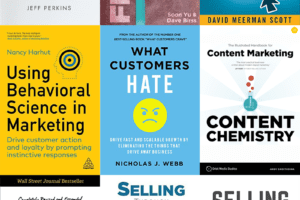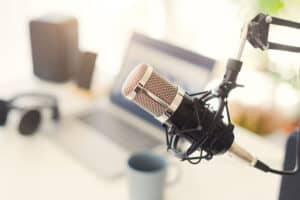Episode 90 of Yes, and Marketing
Gary Swart was formerly the CEO of oDesk and led the company through its merger with eLance to become UpWork, the world’s largest online workplace.
Today Gary is an investor and mentor (including giving me some great advice as Verblio’s marketplace continues to grow) and he agreed to share his wisdom on this episode of Yes, and Marketing.
The conversation is a deep dive on marketplaces, startups, and the future of work:
- What the future of work looks like
- The formula for a successful marketplace
- What happens if you try to grow too quickly
- Common mistakes he sees from sales and marketing teams
- What 90 percent of CEOs have in common
Tap through the chapters above to listen or read on for our highlights from the conversation. You can check also check out clips from all our episodes at our podcast page.
Guest-at-a-Glance
???? Name: Gary Swart
???? What he does: Investor, advisor, and former CEO of oDesk (now Upwork)
????️ Find Gary on the web: Upwork | LinkedIn | Twitter
???? Get smart: “There’s PowerPoint, and there’s Excel. Recognize which one you’re good at and surround yourself with people that are good at the other.”
Top Takeaway
The formula for successful marketplaces ????
“The best marketplaces are where the transaction costs are high and the frequency is high,” Gary says.
In reality, however, many of the most popular marketplaces get only one of those two variables right:
“With an example like Lyft or Uber, your average transaction size is not that great, but you use it all the time. Whereas with these housing marketplaces where you can sell your house—well, the transaction price is exceptionally high, but you only use it once every five to 10 years, If that.”
Gary mentioned one other feature of successful marketplaces: “You’re able to monetize that transaction—or get a piece of it—without people disintermediating,” he explains.
In other words, you need to make sure your buyers and sellers don’t decide to cut out the middleman: you.
How can you do that? By making sure it’s easier or more effective to transact on your platform than off it.
For example, an Uber customer could get their driver’s phone number and call them individually when they need future rides, thus cutting out Uber as the middleman and putting more money in both their pockets. Why don’t we see that happening? Because the likelihood of that particular driver always being nearby and available to drive is low, and they’d need a way to calculate a fair price for each ride, handle payments, etc.—not to mention they would lose the safety and convenience of the app. Ultimately, it’s far more convenient for customers and drivers alike to stay on the platform, even if they are losing a cut to Uber.
Figuring out what convenience your marketplace can offer to both your buyers and sellers—and figuring out how much you, as the middleman, can charge for that convenience—is vital to preventing ‘leakage’ and creating a successful marketplace.
Episode Highlights
Read excerpts from the interview on everything from marketing advice to marketplace dynamics.
Gary’s advice to young marketers
“There’s PowerPoint, and there’s Excel. Recognize which one you’re good at and surround yourself with people that are good at the other.
It’s really hard for people to be exceptional at both. Excel is sort of the growth marketing—it’s leads and it’s the funnel. And PowerPoint is the story. It’s the positioning, the branding, the writing a good story and telling a good story.
And it took me a while to learn that you need both. Sometimes one is more important than the other, and it’s really hard to find all those skills in one person. So recognize what you’re good at and surround yourself with the others.”
Why he wanted to build a marketplace ????
“It’s the opportunity to build an incredibly impactful business. You have supply and demand and a lot of complexity in the middle, so that supply can’t always find that demand. And marketplaces are a way to enable these buyers to find these sellers, regardless of where they are in the world.”
The evolution of marketplaces
“The marketplace is a place where buyers and sellers come together to transact—that’s essentially at the highest level what it is. Marketplaces have changed over the years. Because of technology, they don’t necessarily have to physically come together. eBay was a great example. It wasn’t about going to the flea market and finding the Beanie Baby Pez dispenser—it was leveraging the internet to do that.
The definition of a ‘pure marketplace’
In some cases, you have a marketplace where humans are still very much in that transaction, helping the buyer and the seller to actually transact. The pure marketplaces are the ones where a transaction can happen without human intervention. But over the years, humans have come in and out of that loop. A good example is Amazon. In the early days of Amazon, you couldn’t talk to a human. Then you could, and now you can’t. They sell more and more goods without people.”
Why some marketplaces require more human intervention ????
“In some marketplaces, it’s easier to ensure that the quality is high. In the business that I ran, Upwork, it’s hard to ensure the quality because you’re not really in the middle of the transaction. Yes, you match a buyer and seller, and hopefully you make a great match, but the work that happens from there on out is more like art than it is product.
Whereas in a fixed place marketplace, for example, you want to buy this iPhone case. It arrives as you expected. It looks like it did online. It came quickly. It wasn’t damaged. You’re happy. Or, the ride from point A to point B, it was better than a taxi. They got me there on time and safely. It was cheaper, and I love the app—and if they offered me water and a snack, that was even better.
It’s a lot easier to deliver a good ride than it is good quality work, and so some marketplaces are just harder to manage in a non-touch way than others are.
One common mistake companies make
“I’ve seen so many companies make the mistake of thinking that they’ve nailed the repeatable use case and then adding more capability or capacity on the sales side, only to disrupt their distribution of attainment—the number of reps that are actually hitting quota.
If every sales rep can keep so many balls in the air, as soon as they start dropping them, that’s the time to add another sales rep—not before they have too many balls in the air. You want to nail the repeatable use case before you add too much sales capacity.”
A golden rule for marketplaces
“Bob Cagle, who was an early investor in eBay at Benchmark Partner, told me very early on, ‘If you’re going to build a marketplace, it’s better to build one where if you get one side, the other side will come organically.’ You don’t want to have to recruit for both sides—and it’s even better if you can have some virality.”
His take on the future of work
“I did participate in some, board meetings over the last month on-prem, and there’s no substitute for it. It is fantastic getting together with people, being in the room, going to the whiteboard—the level of conversation and collaboration and ideation when you’re face-to-face, it’s hard to parallel online.
So I do believe that a significant portion of work still needs to be on-premise. It’s just that a large portion of it can be online. I have some companies that are going to get everybody together twice a year, all hands, one location, one week, and then executives or teams quarterly, but most execution will happen remotely. So ideation will happen on-premise, and execution will happen online.”
His top tip for performance marketing ????
“Measuring your funnel, not in aggregate, but across lead acquisition sources is really important. I see companies make this mistake all the time: They say ‘Our CAC is under $50’ and I’ll say, ‘Okay, but what’s your CAC by channel?’
If you break it down, they might realize they’re spending a thousand dollars to acquire a customer on Facebook, and they’re blending it with the customers that are coming for free—but it costs $1000 on Facebook, and their LTV is only $600.
…It’s like, should you even be paying a thousand dollars for a customer? And if they look at what does that Facebook customer net them in revenue, it might be even be less than $600. So, measuring the acquisition by lead source and LTV by lead source is really important.”
The importance of focus ????
“One of my mentors said 90% of CEOs under-focus and 10% over-focus and neither is good. And I was clearly in the 90%, but just recognize which one you are and try and blur the line a little bit, to get yourself more in check.
I would tend to be under-focused and thought everything was an ‘and’ instead of an ‘or,’ and that kills more startups. You’ve heard that: ‘Indigestion kills more startups than starvation.’”
Top Quotes
????️ Gary:
“The best marketplaces are where the transaction costs are high and the frequency is high.”
“In the early days of a marketplace, always, the quality of transaction has to be really high.”
“Sometimes you have to have a lot of human intervention to get that flywheel started, but once it’s started, you can remove the human in the loop.”
“Don’t confuse motion with progress.”
“Don’t underestimate the importance of your story, your brand, and, more importantly, your essence.”
“You’d rather invest in great people at a mediocre business than mediocre people in a great business.”
“Being a great operator or coach or mentor does not make you a great investor.”



